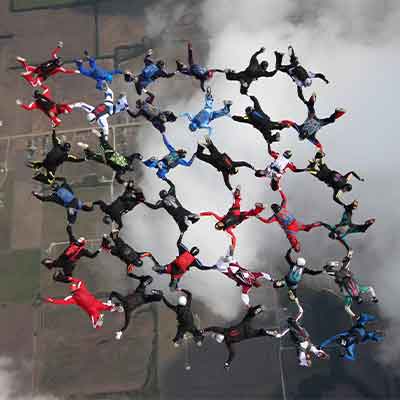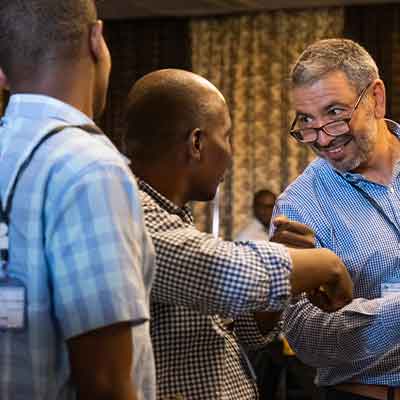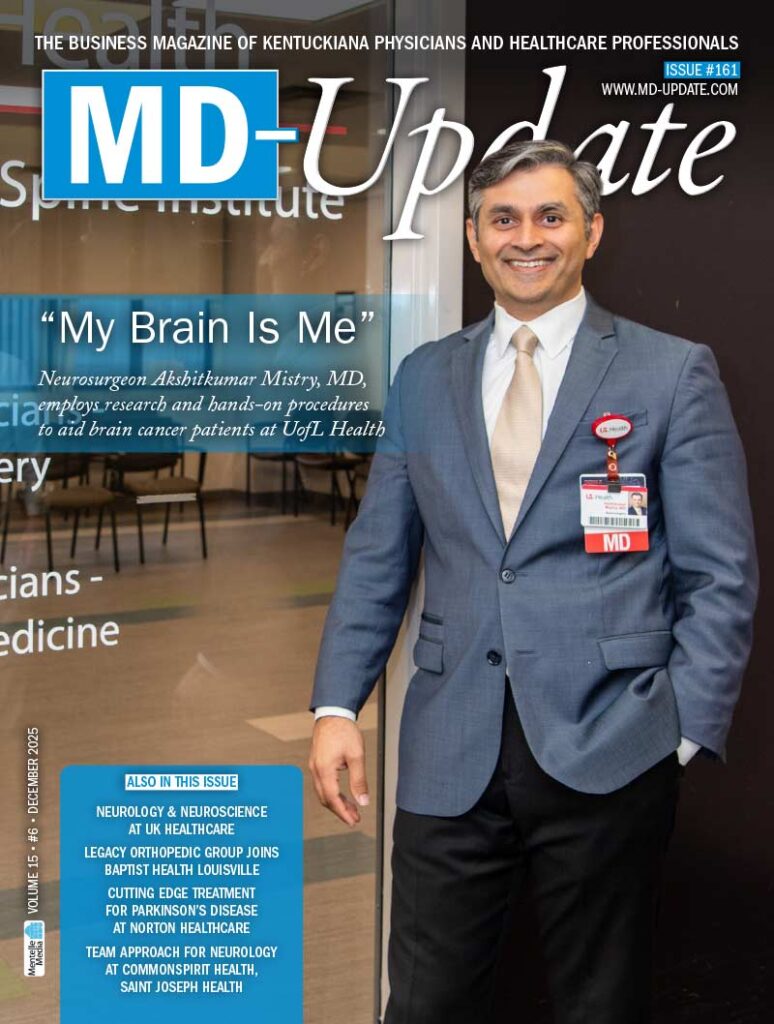Sky-diving orthopedic surgeon Miguel Daccarett, MD, is hip to the latest advancements in joint preservation and replacement
LOUISVILLE They say the definition of insanity is doing the same thing over and over and expecting different results. Well, call Miguel S. Daccarett, MD, FAAOS, insane then because he has safely made more than 3,100 jumps as a professional skydiver, yet he expects the result to be different someday. If and when he sustains an injury, he just hopes that he receives the same professional, attentive care that he attempts to provide his patients as an orthopedic surgeon at the UofL Health.
“As a skydiver, I know I’m going to be on that operating table someday,” says Daccarett, who serves as the associate trauma fellowship program director and as an associate professor in the Department of Orthopedic Surgery at UofL. “Just a little mistake and I will be on that table, so I want my patients to be treated exactly the same as I would like to be treated. I try to communicate this to the people I train.”
That same lesson was likely instilled in him by his father, who was a pediatric surgeon in Colombia and inspired Daccarett to become a doctor as well. He attended medical school at Pontificia Universidad Javeriana in Bogotá. His went on to attend El Bosque University to become an orthopedic surgeon. He completed a trauma fellowship at the University of Louisville, an oncology fellowship at the University of Florida, and a sports medicine fellowship at Harvard Children’s Hospital.
Today, he is a board-certified orthopedic surgeon, specializing in orthopedic trauma and sports medicine. Among the conditions he treats are fractures of the pelvis, acetabulum, hip, knee, ankle, and upper and lower extremities, with particular interest and training in hip preservation surgery to avoid early hip replacement.
“I was living in Columbia at probably in the worst time of Columbia’s history,” says Daccarett, explaining how he became interested in orthopedics. “Initially, I wanted to be a cardio thoracic surgeon, but when the war in Columbia started, the musculoskeletal traumas — the fractures, all the bone injuries — I was surrounded by those types of patients. Orthopedics slowly became my cause in life.”
After working at the University of Chicago, Daccarett learned of an opportunity to return to the University of Louisville in 2023. Having fond memories of Louisville and knowing all the surgeons he would be working with, he eagerly accepted.
His work is a combination of clinics and surgeries, with the organization of courses mixed in. He estimates that he spends oneand-a-half days a week in the clinic and three days a week in surgery, which also sometimes doubles as a teaching opportunity.
“Teaching has migrated from lectures of 45

minutes to an hour to a more dynamic way to exchange ideas,” says Daccarett. “When I started teaching nationally 20 years ago, all the teachings were formal lectures. Now, most of the courses we do are based on cases of trauma — a broken femur, for example. The trainees ask and answer questions themselves, and we guide those answers to have a better application of the knowledge into our real cases. It’s more dynamic and more applicable to the needs of the patients.”
Daccarett, whose oldest patient to date was a 103-year-old with a hip fracture, treats a patient population that includes all ages and genders. Such a broad spectrum requires taking the time to understand the varied needs of each patient.
“When you treat a patient in trauma, the goals can be completely different,” says Daccarett. “For an athlete 20 years old, the

goal might be to come back to play football again. For a 50-year-old, it might be able to walk without pain, and for an older patient it might be to take care of themselves.
“When we meet with patients, we set the goals,” Daccarett continues. “I want to know when and how the problem started. Is there a history of trauma? What makes it better? What makes it worse? Once we define what the problem is, I want to know what the patient’s goals are to be able to decide on a specific treatment for that patient.”
Hip Replacement or Preservation
While his overall patient population spans all ages, Daccarett’s hip preservation patients fit into a much smaller age range. These patients range in age from about 12 to 40 years old; he describes the ideal patient for this procedure as a 20-year-old presenting with dysplasia of the hip due to the socket being underdeveloped. The resulting treatment corrects the hip and creates a more normal weight-bearing hip. On the other hand, a patient presenting with severe arthritis, for example, is not a good candidate for hip perseveration and would likely benefit more from a total hip replacement.
“Hip preservation is not something that everybody does,” says Daccarett. “It requires specific training and experience. It is not as common as replacing a hip or knee. Not too many people know that we can save those joints, especially in late adolescence or early adult life. It is a misconception that once you have damage to the cartilage of the hip, you have to replace it. In many cases, we can just replace the portion that is damaged and preserve the hip.”
Daccarett says that recent progress in hip procedures now allows specialists like himself to potentially manipulate and realign the acetabulum to a better position. In other instances, vascular necrosis can often be corrected via surgical dislocation of the hip and replacement of the bone and cartilage with a new bone from a donor.
“The femoral head has a good amount of diseases or malformations that can happen, including a slipped cap, in which we can go inside the hip and do surgical dislocation of the hip,” says Daccarett. “Through surgical dislocation of the hip, we can work the femoral head and make it more normal so the patient can bear weight on that hip.”
Despite the advancements in hip preservations, there are still times when a total hip replacement is the best course of action. Daccarett gives the example of a patient who is overweight, has diabetes, and is a smoker. For such a patient, the risks of performing hip preservation are heightened, and a hip replacement is often the preferred course of action.
“Fortunately, the evolution of the total hip replacement allows you to have a new hip and be able to be active, including running, biking, or swimming,” says Daccarett. “The patient can have an active, healthy sporting life.”
Rehabilitation Is Key
Regardless of whether the procedure is hip preservation or hip replacement, Daccarett points out that rehabilitation is key to eventual success.
“More important than the operation itself is rehabbing the patient,” he says. “We work together with rehabilitation doctors to protect the operation we did and, at the same time, not let the patient get too stiff. They will create a rehabilitation program in which the range of motion can be performed without all of the weight on the lower extremities.”
Daccarett has a clear passion and dedication to helping his patients in whatever manner best fits their needs and goals. He follows through on that commitment by staying informed on the latest techniques and advancements.
“My philosophy of care is patients come first,” says Daccarett. “I treat patients as if they are members of my own family — with compassion, professionalism, and common sense. I have a commitment to my patients and their families to deliver care that is supported by evidence-based medicine and performed in a multidisciplinary fashion.”
It is a commitment he hopes he instills in other orthopedic surgeons… whether or not he actually ever needs their care himself



